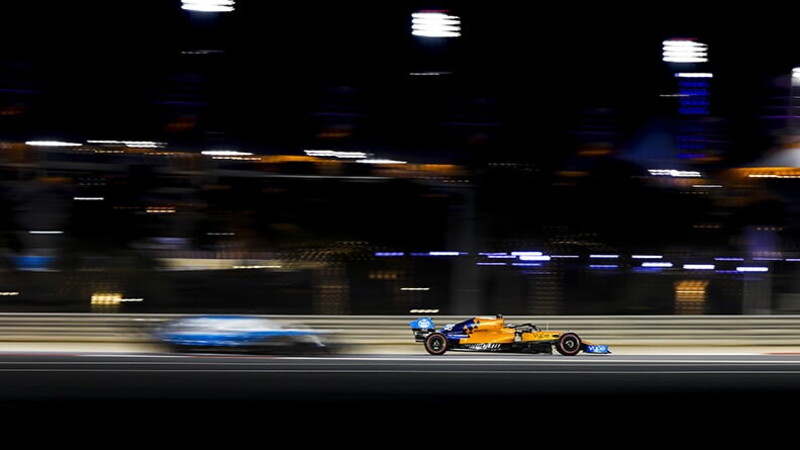F1 Sakhir Grand Prix: feeling the burn

In Bahrain, there will be two races on the same track seven days apart, just as there were in Austria in July and Great Britain in August. That's a result of the idiosyncratic 2020 Formula 1 season, which will forever be remembered for Covid, but also for the resilience of the sport, which overcame the challenges posed by the virus to put on a show that was truly worthy of the world championship.
But Sakhir, which has hosted the Bahrain Grand Prix since 2004, goes one step further: it's the first venue to host back-to-back races on the same circuit but not on the same track layout. The race that takes place on Sunday 6 December, the penultimate grand prix of the season, will introduce something entirely different. It won't be on the regular 5.4-kilometre circuit covered at an average speed of 221kph in qualifying (Ferrari driver Charles Leclerc's pole time last year, who went on to dominate the race before encountering a technical problem) but instead on a much shorter circuit where lap times will be a minute or lower: making it the shortest lap in the history of the Formula 1 world championship.
Hermann Tilke's creation
The Bahrain International Circuit – located around 20 minutes outside the kingdom's capital of Manama – has always pointed to the future of Formula 1. It was the second circuit in a series of tracks designed by Hermann Tilke (popularly known as ‘Tilkedromes'). The German circuit architect, appointed by former F1 boss Bernie Ecclestone, is responsible for many of the tracks now seen on the F1 calendar; most of which have certain elements in common. We're talking about long straights and variable radius corners, which tend to be wide and with limited elevation changes. Another hallmark is generous – perhaps overly generous – run-off areas. One of the reasons behind this is to provide uninterrupted views for television cameras, which can help them also to alter the perspective. Another reason is to – quite literally – not put anything in the way of the drivers, who know that going off the road no longer represents any real danger, or even a significant time loss.

The “Tilkedromes” make their mark
This unique style of track was first seen at the end of the 1990s in Malaysia. Sepang introduced Formula 1 to mainland Asia in 1999 (although there had already been a Japanese Grand Prix for many years) and the biggest danger was probably represented by the snakes inhabiting the nearby jungle, which nonetheless occasionally ventured out onto the track. That was about the most drivers had to worry about in terms of safety. Bahrain then followed Sepang, and after that there was Shanghai and Singapore, followed by Abu Dhabi, Yeongham in Korea, and New Delhi in India, not to mention Austin and Sochi – also still featured on the F1 calendar now. These were all beautiful, new and smooth circuits, as flat as an airport runway (with Austin being a notable exception thanks to the spectacular downhill hairpin after the start-finish straight) but still featuring high safety standards with those ample run-off areas. Three-time world champion Jackie Stewart had an alternative take, saying that the Tilkedromes didn't just provide high levels of safety, but also a free pass for drivers to make mistakes without worrying about hurting themselves – undoubtedly a good thing – or losing any time; instead just popping back onto the race track after only fractions of a second.
It's a criticism that could appear slightly detached from this year's unusual calendar though, which has witnessed the arrival (or return) of emotive tracks such as Mugello, Imola and Portimao, to the delight of the drivers.

A demanding track for tyres
Sakhir is a bit different: with a wide and flat track, plus plenty of open space. But this doesn't mean that the circuit doesn't contain a few challenges. To start with, the asphalt is really abrasive: a proper cheese-grater of a track that places a massive challenge on the tyres, enhanced by the frequent high temperatures (often exceeding 50 degrees on track) that provide an additional challenge for engines and cooling. But the other interesting thing about Sakhir is that it provides several track different layouts. In 2010, to celebrate 50 years of Formula 1, a longer lap was used, but in 2012 – following a year out from the calendar for political reasons – the 6299-metre was abandoned to return to the layout that was used up until last Sunday for the Bahrain Grand Prix.
And now, for the Sakhir Grand Prix on December 6, it's time to try a layout that's never been used for Formula 1, with an almost oval layout that presents an entirely different picture. This leaves several question marks in terms of driving style and demands on cars and tyres. It will also be a full night race (as opposed to the Bahrain Grand Prix, which starts in the late afternoon and finishes in the evening) so artificial light will add to the challenge.
That's all part of the uniqueness of Bahrain: with its abrasive granite surface that hosted Formula 1's first race in the Middle East, securing a permanent place in the sport's history. A race with a passion and ambition that seems almost infinite. Now, the latest chapter: a novel grand prix – with the titles already decided – that will quite literally come down to survival of the fittest. It's last man standing in Bahrain…




